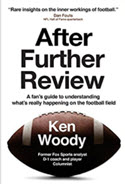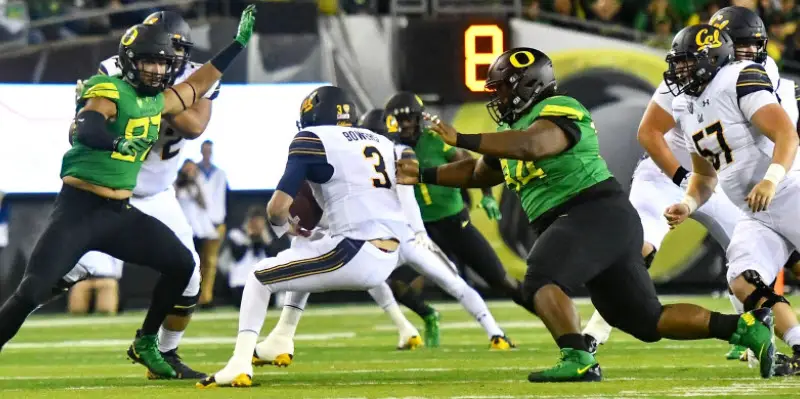Coach Willie Taggart notched his first Pac-12 conference win behind a strong push from not only a much-maligned offensive line and a fierce pass rush from an improving defense, but also a host of capable replacements who were thrown into action after a succession of key injuries cast a pall on the Autzen Stadium crowd.
Going into Saturday’s key match-up with unbeaten Washington State and fresh off an upset of USC, Taggart no longer has the use of Justin Herbert, Royce Freeman (possibly), backup quarterback Taylor Allie, and receiver-punt returner Dillon Mitchell. Redshirt quarterback Braxton Burmeister, who was mainly holding a clipboard the first four games, threw off the redshirt and hurried onto the field behind center after Allie was knocked senseless in the fourth quarter.
Freeman gets off to a great start on this play (above) but ends up injuring his shoulder when he is tackled after a 13-yard gain. After heavy criticism for soft and lazy play, the Ducks’ offensive line gets their pad level low and steamrolls Cal. Curiously, this example shows the Bears in a three-man front with two inside backers, giving them only five defenders defending six gaps.
The Ducks’ right tackle caves the defensive tackle inside, the right guard seals Cal’s linebacker inside, and Freeman cuts outside. Watch him carefully — He makes a quick head fake on the linebacker, which makes him spread his feet. He can’t keep up to Freeman’s quickness. The outside defender is out of control with his feet together. Freeman eludes his diving tackle attempt and gets even more yardage, thanks to the efforts of receivers blocking downfield.
The Cougs will have to contend with Oregon’s play-action passing attack similar to this touchdown against the Bears. With two backs in the backfield, Herbert fakes play action to his right halfback. Meanwhile the left back releases on a wheel route up the sideline with a mis-matched linebacker attempting to stay with him. Wide open, Herbert spots the split end on a post route for a score. The Bears’ secondary messed up here. The right corner is aligned outside the split end. This gives the impression he is in zone coverage, expecting help from a safety inside who is nowhere in the vicinity.
If the safety is right and Cal is in man coverage, the corner should have lined up to the inside of the receiver and denied him the post cut. If the corner is right, then the safety is wrong, and you see what happens when there is a mistake in the secondary. The Ducks need to avoid these kinds of mistakes themselves taking on Luke Falk, the Cougars’ outstanding quarterback, who makes a living off of confused defensive backs.
Oregon’s defensive line totally dominated the Bears’ offensive line, lowered their pad levels like the Ducks o-line did, stayed square in their gaps and showed physical strength in the use of their hands and arms, not allowing blockers to get to their chests. They lowered the Bears’ pad levels like the Ducks o-line did, stayed square in their gaps, and showed physical strength in the use of their hands and arms, not allowing blockers to get to their chests. Sophomore Drayton Carlberg (No. 90 and third Ducks up from bottom) knows the gap he must defend in this example above. He fires off the ball quickly, nullifies the charge of the offensive lineman, and despite the blocker on him, is able to make the tackle. The entire Duck front seven displays an excellent example of gap control, which is as important to run defense as pass rush and contain are to effective pass defense.
Any time good passing teams see a defender in bump or “press” coverage, there is a chance they will adjust their play to a rub pass pattern. Washington State will do this because they saw two examples go for big yardage against the Ducks in the Cal game. In this example, the outside receiver comes off the ball (pushing off a bit) and runs his corner backwards and inside, toward the defensive back covering the slot receiver. The slot receiver starts up field a few steps to back his defender up and then breaks out and up the sideline. The inside defender has to run in front of Cal’s split end to avoid a collision, and in so doing, loses two steps that he is never able to make up — a mismatch between a slower safety and the Bears’ best receiver.
This is a difficult play to defend, and you will also see it close to the goal line out of a variety of formations. You might defend it in man coverage by fighting through the pick or switching like they do in basketball. The Duck corner should have contacted the split end and prevented him from picking the inside defender. The inside defender also should have ran around behind the pick because the deep route is the most dangerous. If he goes behind and the receiver breaks it off to the flat, then you are still between him and the end zone and can limit the gain. The coach could also resist playing press coverage on either the slot or split receiver to limit the easy rub. Mess this coverage up and you pay for it in points.
Cougars Eager to Exploit Youthful Duck Secondary
Facing the youth in the Duck secondary, Falk and coach Mike Leach are probably licking their chops at the possibilities. A fierce pass rush would make it a bit easier as Oregon faces the heir-apparent all-time Pac-12 passing leader. Then, coach Taggart only has to worry about a healthy quarterback and scoring enough points to upset the Cougars who might be distracted after one of the great home wins in WSU history.
Coach Ken Woody
Eugene, Oregon
Top photo credit: Scott Kelly
Ken Woody is a former Fox Sports football commentator who played defensive back, receiver and kicker for Oregon from 1966 to 1970. He coached college football for 18 years, including stints as an assistant coach at Oregon, Washington, Washington State and Utah State, and was head coach at Whitman College and Washington University-St. Louis.
 Buy the book to learn from Coach Woody, or give a gift of football.
Buy the book to learn from Coach Woody, or give a gift of football.
“Every Oregon fan should have a copy to learn from as I do.” Charles Fischer
Related Articles:
Seven Offensive Coordinator Candidates for the Oregon Ducks
Five Candidates to Replace OC Marcus Arroyo
Coach Jim Mastro: The Perception, and the Truth
Has Oregon Turned the Corner on Offense?
Ducks, Taggart Punish Beavers; Earn Bowling Trip
Textbook Defense, Herbert's Return Energize Duck Victory; Civil War Next
“I learned football working under many great coaches, among them Len Casanova, Jerry Frei, John Robinson, Bruce Snyder, George Seifert,and Ron Stratten at the University of Oregon, Jim Owens at the University of Washington and Jim Walden at Washington State University. Most of my coaching experience was on the offensive side of the ball with quarterbacks, receivers and kickers although as a head coach I coached defensive backs, linebackers and offensive line.
I achieved my first goal of being the youngest head coach in college football at the age of 26 and throughout my career in coaching and outside of it, as a journalist and broadcaster, have experienced how exciting and gratifying it is teaching the game to others.”

